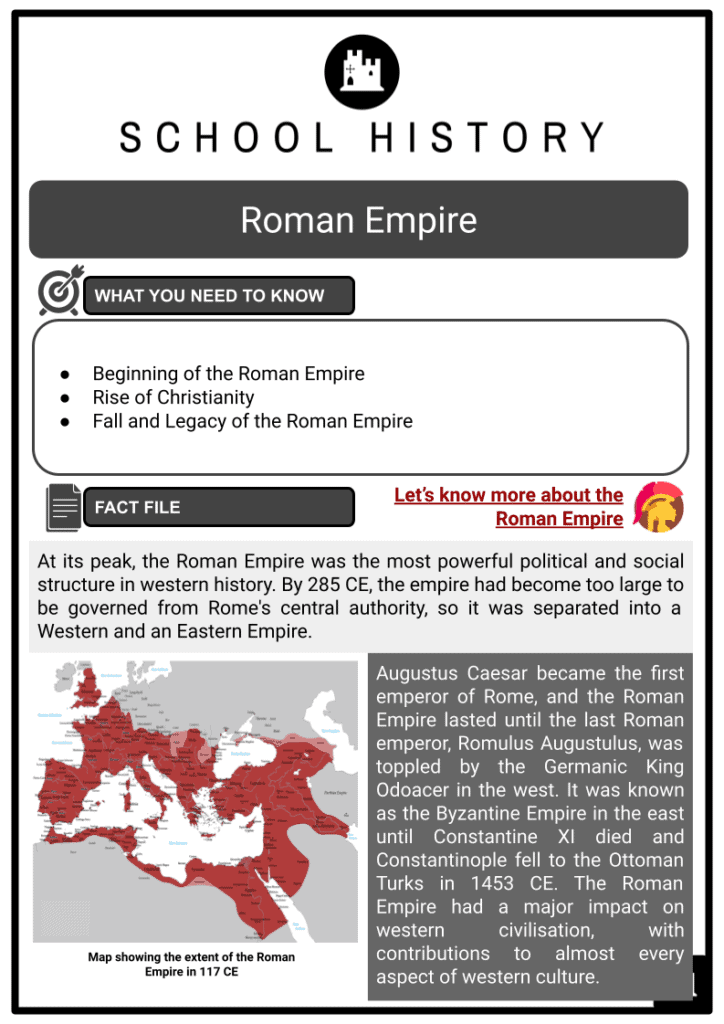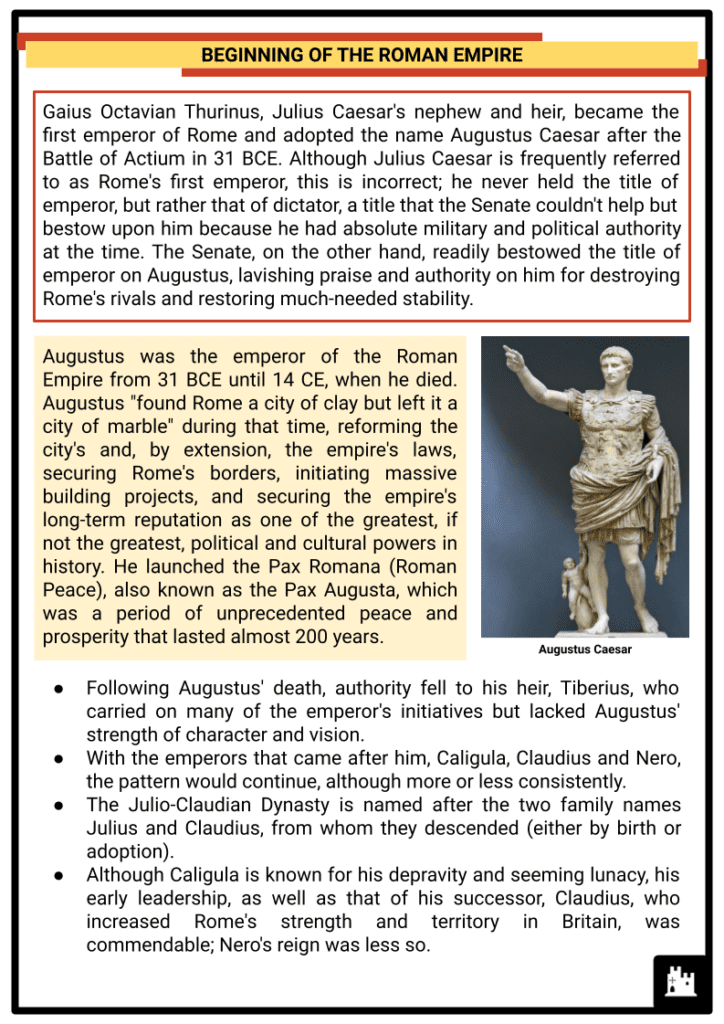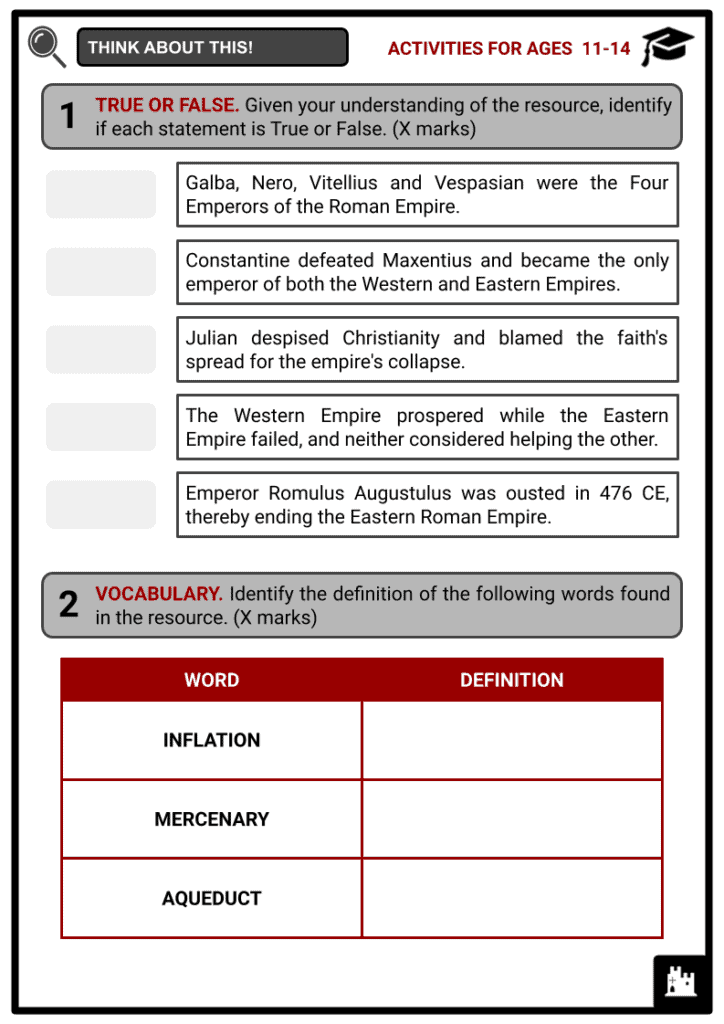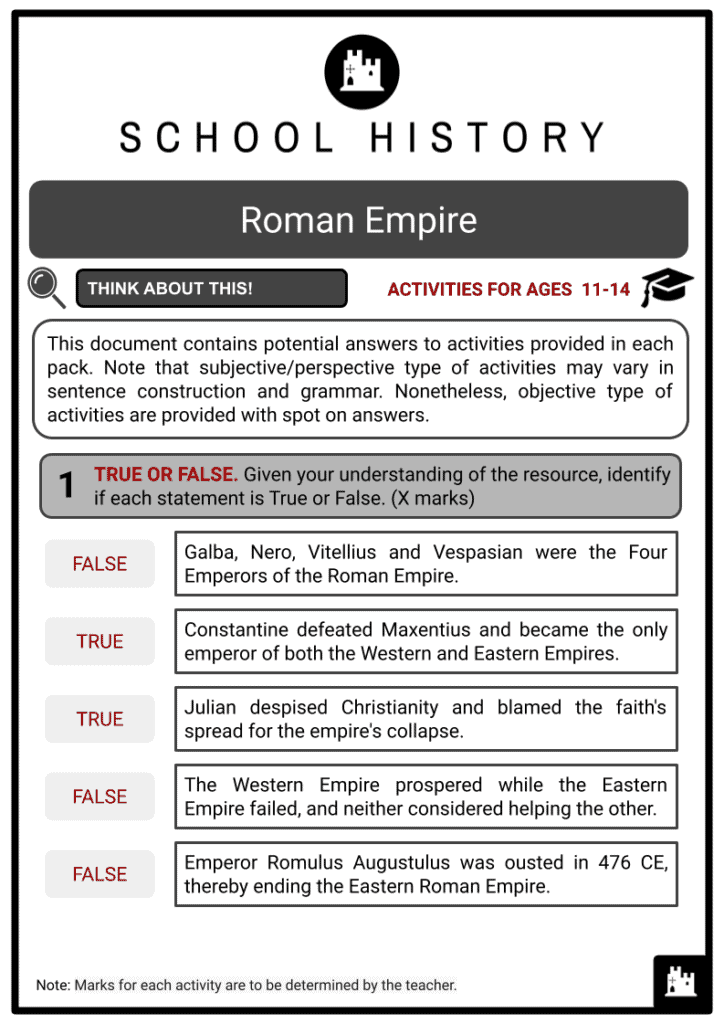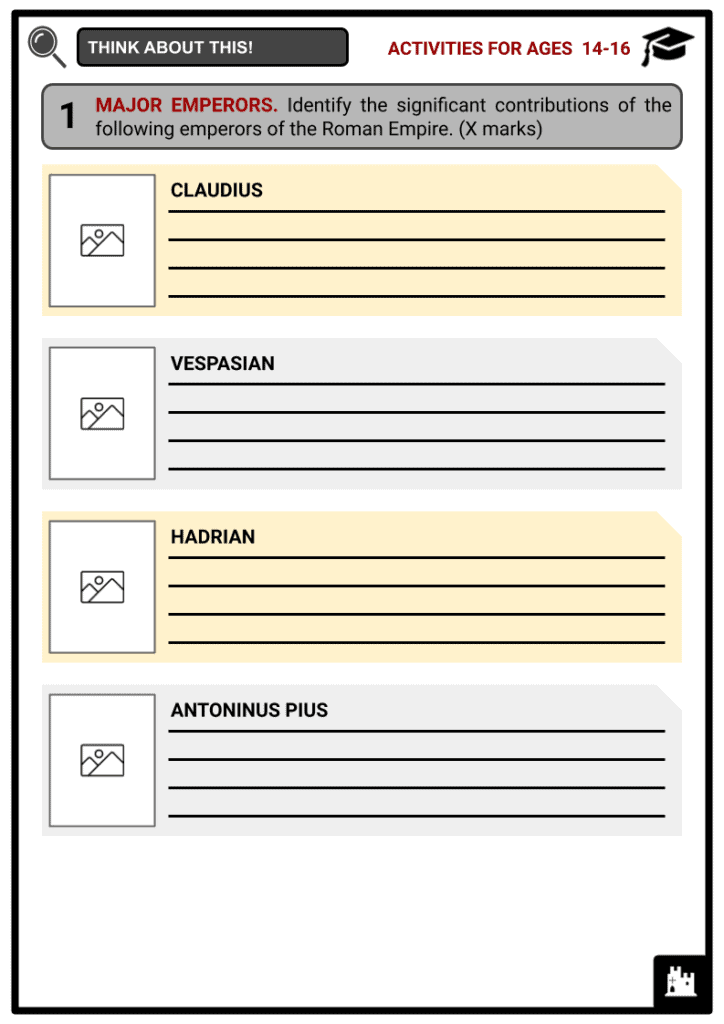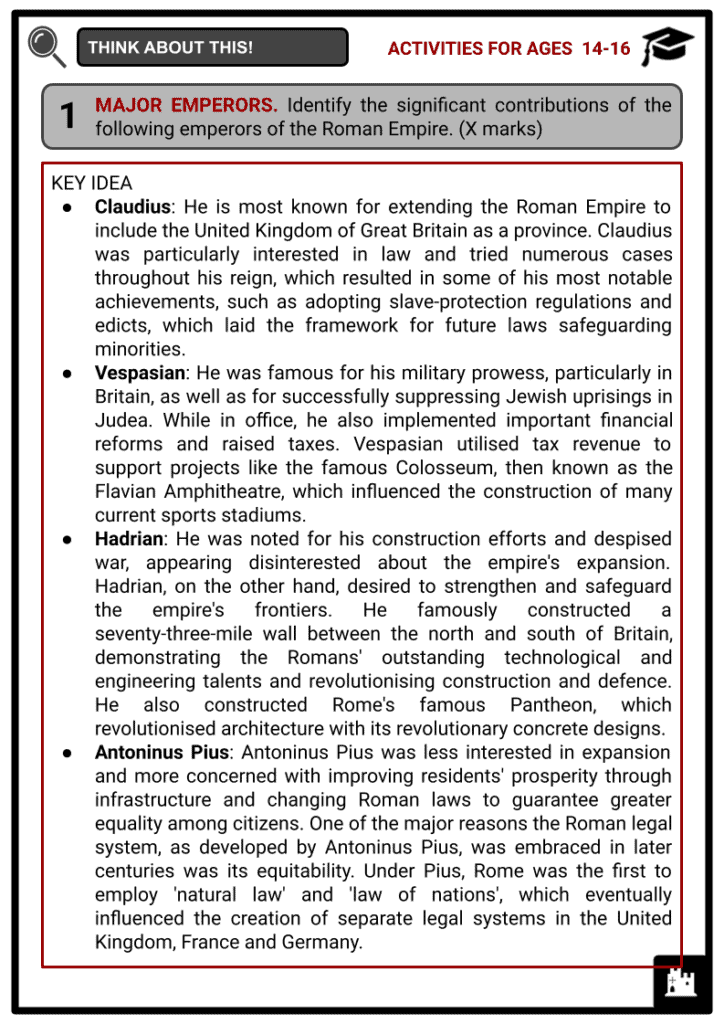Roman Empire Worksheets
Do you want to save dozens of hours in time? Get your evenings and weekends back? Be able to teach about the Roman Empire to your students?
Our worksheet bundle includes a fact file and printable worksheets and student activities. Perfect for both the classroom and homeschooling!
Summary
- Beginning of the Roman Empire
- Rise of Christianity
- Fall and Legacy of the Roman Empire
Key Facts And Information
Let’s find out more about the Roman Empire!
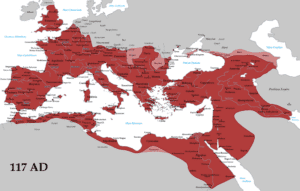
At its peak, the Roman Empire was the most powerful political and social structure in western history. By 285 CE, the empire had become too large to be governed from Rome's central authority, so it was separated into a Western and an Eastern Empire.
Augustus Caesar became the first emperor of Rome, and the Roman Empire lasted until the last Roman emperor, Romulus Augustulus, was toppled by the Germanic King Odoacer in the west. It was known as the Byzantine Empire in the east until Constantine XI died and Constantinople fell to the Ottoman Turks in 1453 CE. The Roman Empire had a major impact on western civilisation, with contributions to almost every aspect of western culture.
BEGINNING OF THE ROMAN EMPIRE
- Gaius Octavian Thurinus, Julius Caesar's nephew and heir, became the first emperor of Rome and adopted the name Augustus Caesar after the Battle of Actium in 31 BCE. Although Julius Caesar is frequently referred to as Rome's first emperor, this is incorrect; he never held the title of emperor, but rather that of dictator, a title that the Senate couldn't help but bestow upon him because he had absolute military and political authority at the time. The Senate, on the other hand, readily bestowed the title of emperor on Augustus, lavishing praise and authority on him for destroying Rome's rivals and restoring much-needed stability.
- Augustus was the emperor of the Roman Empire from 31 BCE until 14 CE, when he died. Augustus "found Rome a city of clay but left it a city of marble" during that time, reforming the city's and, by extension, the empire's laws, securing Rome's borders, initiating massive building projects, and securing the empire's long-term reputation as one of the greatest, if not the greatest, political and cultural powers in history. He launched the Pax Romana (Roman Peace), also known as the Pax Augusta, which was a period of unprecedented peace and prosperity that lasted almost 200 years.
- Following Augustus' death, authority fell to his heir, Tiberius, who carried on many of the emperor's initiatives but lacked Augustus' strength of character and vision.
- With the emperors that came after him, Caligula, Claudius and Nero, the pattern would continue, although more or less consistently.
- The Julio-Claudian Dynasty is named after the two family names Julius and Claudius, from whom they descended (either by birth or adoption).
- Although Caligula is known for his depravity and seeming lunacy, his early leadership, as well as that of his successor, Claudius, who increased Rome's strength and territory in Britain, was commendable; Nero's reign was less so.
- Both Caligula and Claudius were assassinated while in power (Caligula by his Praetorian Guard and Claudius, apparently, by his wife).
- Nero's assassination brought an end to the Julio-Claudian Dynasty and the start of the Year of the Four Emperors, a time of social unrest.
- Galba, Otho, Vitellius and Vespasian were the Four Emperors. Following Nero's assassination in 68 CE, Galba ascended to the throne in 69 CE and quickly showed that he was unsuited for the position. The Praetorian Guard assassinated him. On the day of his death, Otho succeeded him, and ancient sources show that he was supposed to be a good emperor. General Vitellius, on the other hand, desired power for himself and so began the brief civil war that resulted in Otho's suicide and Vitellius' ascension to the throne.
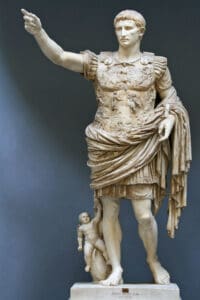
Augustus Caesar - Vitellius showed himself to be no more suitable to lead than Galba had been, as he quickly became engaged in expensive entertainments and feasts at the cost of his responsibilities. General Vespasian was proclaimed emperor by the legions, who marched on Rome. Vitellius was assassinated by Vespasian's men, and Vespasian (r. 69-79 CE) came to the throne precisely one year after Galba did.
- Vespasian established the Flavian Dynasty, which was known for large construction projects, economic success, and imperial expansion. Vespasian's rule was rich, as indicated by his construction projects, which included the beginning of the Flavian Amphitheatre (the famed Coliseum of Rome), which his son Titus would finish. The eruption of Mount Vesuvius in 79 CE, which buried the towns of Pompeii and Herculaneum, occurred during Titus' early reign.
- His management of this disaster, as well as the catastrophic fire of Rome in 80 CE, is widely lauded in ancient texts. Titus died of a fever in 81 CE, and his brother Domitian succeeded him. Domitian enhanced the empire's economy by expanding and securing the city's borders, repairing the damage caused by the great fire, and continuing his brother's building projects. Despite this, the Roman Senate despised his autocratic ways and ideas, and he was assassinated in 96 CE.
RISE OF CHRISTIANITY
- In the Battle of the Milvian Bridge in 312 CE, Constantine defeated Maxentius and became the only emperor of both the Western and Eastern Empires (ruling from 306-337 CE but holding supreme power 324-307 CE). Constantine, believing that Jesus Christ was responsible for his triumph, enacted a series of laws, such as the Edict of Milan in 313 CE, mandating religious tolerance across the empire, including tolerance for the faith that became known as Christianity.
- Constantine adopted the figure of Jesus Christ in the same manner that previous Roman emperors had claimed a unique relationship with a deity to enhance their power and position. He presided over the First Council of Nicea, which was held to clarify the religion and deliberate on major topics like Jesus' divinity and which manuscripts would be collected to become the Bible we know today.
- He consolidated the empire, revalued the currency, and restructured the military, as well as establishing New Rome on the site of Byzantium (modern-day Istanbul), which later became known as Constantinople.
- Later Christian authors referred to him as Constantine the Great, although as many historians have pointed out, the title may just as much be credited to his religious, cultural and political reforms as his military prowess and large-scale construction projects.
- After Constantine's death, his sons inherited the empire and swiftly began a series of rivalries with one another, threatening to ruin everything Constantine had achieved.
His three sons, Constantine II, Constantius II and Constans, split the Roman Empire among themselves, but soon quarrelled over who deserved more. Constantine II and Constans were slain in these battles. Later, after choosing his cousin Julian as his successor and heir, Constantius II died. Emperor Julian reigned for barely two years from 361 to 363 CE, during which time he attempted to restore Rome to its former splendour by instituting a number of reforms aimed at improving administrative efficiency.
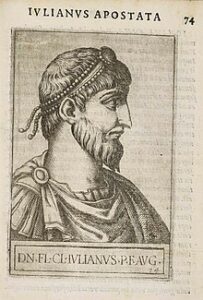
- Julian, a Neo-Platonic philosopher, despised Christianity and blamed the faith's spread, as well as Constantine's support for it, for the empire's collapse. Julian gradually removed Christians from prominent government positions, prohibited the teaching and spread of the faith, and forbade Christians from military service, all while declaring a policy of religious tolerance. Constantine's dynasty came to an end when he died in battle against the Persians. He was Rome's last pagan emperor, and his hostility to Christianity earned him the title 'Julian the Apostate'.
- After Jovian's brief reign, in which he re-established Christianity as the empire's dominant faith and repealed Julian's various edicts, Theodosius I carried out the religious reforms of Constantine and Jovian, which resulted in the banning of pagan worship and closing of schools throughout the empire. Christianity was proclaimed as Rome's state religion and pagan temples were converted into Christian churches.
- The great Academy of Plato was shut down by Theodosius during this time. Many of his changes were controversial among both the Roman nobility and the common people who adhered to pagan traditions. The formation of a religion that withdrew the gods from the earth and human society and declared just one god who reigned from the heavens shattered the unity of social duty and religious belief that paganism provided.
- Unlike previous gods, this new god had no specific interest in Rome – he was the god of all people – and thereby separated Rome's religion from its state. Previously, Roman religious belief was state-sponsored, with rites and festivals aimed at elevating the government's position. Theodosius I spent so much time promoting Christianity that it appears he ignored his other responsibilities as emperor, and he would be the last to lead both the Eastern and Western Empires.
FALL AND LEGACY OF THE ROMAN EMPIRE
- The Gothic Wars, which lasted from 376-382 CE, were a series of wars between Rome and invading Goths. The Roman Emperor Valens was defeated in the Battle of Adrianople on 9 August 378 CE, and historians consider this event to be significant in the collapse of the Western Roman Empire. Various ideas have been proposed as to the reason for the empire's demise, but no common agreement exists on what those specific factors were even now. In his book The History of the Decline and Fall of the Roman Empire, Edward Gibbon famously contended that Christianity had a crucial part in the empire's decline and fall, arguing that the new religion weakened the empire's social mores, which paganism provided.
- The theory that Christianity was an underlying cause in the empire's collapse was openly discussed long before Gibbon, however, as the theologian Orosius argued Christianity's innocence in Rome's fall as early as 418 CE. According to Orosius, the collapse of Rome was caused chiefly by paganism and pagan practices. Other elements that contributed to Rome's decline include: political instability caused by the empire's size, the self-interest of the empire's two parts, barbarian tribal invasions, government corruption, mercenary armies, over-reliance on slave labour, and massive unemployment and inflation.
- The empire's unmanageable size, even when divided in two, made it impossible to control.
- The Eastern Empire prospered while the Western Empire faltered, and neither considered helping the other.
- Eastern and Western Rome saw each other as rivals rather than allies, and they worked solely for their personal benefit.
- If not for government corruption, particularly among provincial governors, and the Romans' overall equitable treatment of the Goths, the expanding strength of the Germanic tribes and their continuous incursions into Rome could have been dealt with more efficiently.
- The Roman military, which was mostly made up of barbarian mercenaries with no ethnic links to Rome, could no longer protect the borders as effectively as before, nor could the government collect taxes in the provinces as readily as before. Furthermore, the debasement of the currency, which began under the Severan Dynasty, had progressively fuelled inflation, and extensive slave labour had robbed lower-class individuals of work, resulting in high unemployment rates. The emergence of the Visigoths in the empire in the third century CE, escaping invading Huns, and their subsequent rebellions have also been blamed for the empire's demise.
- The Germanic King Odoacer ousted Emperor Romulus Augustulus, ending the Western Empire on 4 September 476 CE (though some historians associate the fall of the empire with the death of Julius Nepos in 480 CE). The Eastern Roman Empire was known as the Byzantine Empire until 1453 CE, and while being referred to as simply 'the Roman Empire' at the time, it had nothing in common with that organisation. The Holy Roman Empire would subsequently re-invent the Western Roman Empire, although it, too, was far distant from the ancient Roman Empire and was only an 'empire' in name.
- The Roman Empire's inventions and innovations greatly influenced the lives of ancient peoples, and they are being employed in civilisations throughout the world today. The Romans devised or improved upon advancements in road and building construction, indoor plumbing, aqueducts, and even fast-drying cement.
- The Western calendar is based on Julius Caesar's creation, and the names of the days of the week and months of the year are likewise derived from Rome. Even the practice of returning a purchase that one does not want can be traced back to Rome, where regulations made it permissible for a customer to return defective or undesired goods to the merchant.
- Shoes, a postal system, cosmetics, the magnifying glass, and the concept of satire in literature were all established by the Romans, as were apartment complexes, public bathrooms, locks and keys, newspapers, and even socks. Significant advancements were also made in the fields of medical, law, religion, governance and military throughout the reign of the empire. The Romans were skilled at acquiring and expanding upon the innovations and notions found among the native populations of the lands they conquered.
- As a result, determining what is an 'original' Roman invention versus what is an improvement to an existing idea, method or equipment is challenging. However, it can be fairly stated that the Roman Empire left an enduring legacy that continues to influence how people live today.

